 Unless your pet is the dog in a plastic bubble there is no way to eliminate exposure to parasites. Parasites come in many forms, and your pet can come into contact with them through food, water, the ground, the environment, and even the air. Animals large and small act as hosts to parasites. Whales have whale lice, and honeybees have bee mites.
Unless your pet is the dog in a plastic bubble there is no way to eliminate exposure to parasites. Parasites come in many forms, and your pet can come into contact with them through food, water, the ground, the environment, and even the air. Animals large and small act as hosts to parasites. Whales have whale lice, and honeybees have bee mites.
It’s critical to note that unhealthy pets make the best hosts to parasites, whereas healthy pets are much better equipped to fend off the vermin. The best thing you can do to prevent parasitic problems is to feed your pet a well-balanced raw diet made from quality ingredients. Exercise and pure water are also beneficial factors to overall health.
Below are some common parasites that affect our dogs and cats.
Fleas
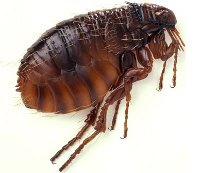 If you find a flea, don’t overlook the problem hoping that it will go away. Fleas multiply quickly, and if you see one, there are many more that you haven’t seen. Natural flea treatment requires patience.
If you find a flea, don’t overlook the problem hoping that it will go away. Fleas multiply quickly, and if you see one, there are many more that you haven’t seen. Natural flea treatment requires patience.
What you don’t want to do is weaken your pet’s health by subjecting the dog or cat to toxic poisons that are in many conventional flea-control products. You want to try to keep your pet as healthy as possible, because a healthy pet will fend off fleas naturally, and will make a much less attractive host. For tips on general dog and cat health, see Overview, Holistic Veterinary Care, the immune system section of the Infections page, and various other pages in our Ailments A-Z section.
For optimal health, feed your pet a quality, balanced, natural diet made with raw meat and other fresh ingredients. Also, see that your pet gets adequate exercise and quiet time, and that water is from a pure source.  Exercise not only safeguards your pet’s cardio-vascular system, it also stimulates the removal of toxins via hardy circulation. The digestive tract, lungs, liver, kidneys, and skin all work at eliminating wastes. Because toxins escape the body through the skin, regular grooming is a good way to keep your pet clean and flea-free. This doesn’t mean taking your pet to a groomer, necessarily, but merely following the guidelines below.
Exercise not only safeguards your pet’s cardio-vascular system, it also stimulates the removal of toxins via hardy circulation. The digestive tract, lungs, liver, kidneys, and skin all work at eliminating wastes. Because toxins escape the body through the skin, regular grooming is a good way to keep your pet clean and flea-free. This doesn’t mean taking your pet to a groomer, necessarily, but merely following the guidelines below.
Bathing and brushing needs vary from pet to pet. Animals with long hair ought to be brushed every day, shorter haired breeds less frequently. Pets who are in prime health don’t require as much brushing because their skin doesn’t expel as many toxins. In any case, brushing and combing help with the condition of your pet’s skin and coat because they distribute natural oils and discourage fleas.
Bathing is important if your pet gets dirty regularly, is eliminating a lot of toxins through the skin, has fleas, or is susceptible to flea infestation. Don’t bathe your pets too often, though, or you can dry out their skin. Cats often don’t need bathing because they are fastidious groomers. Unless your dog is unusually dirty, bathing once every couple of months is fine. If, however, your pet has fleas or skin discharge, you may want to give a bath once a week. Use a mild, natural shampoo or castile soap that doesn’t strip the oils too harshly, and always make sure you thoroughly rinse all soap off afterward. Leaving soap on your pet will cause itching.
A trick when you’re bathing a pet with fleas is to start by making a ring of soap around the neck. This stops fleas from seeking higher ground and crawling into ears, which they like to do when dunked under water. For an after-bath rinse, cooled rosemary tea makes a good coat conditioner and flea repellent.
 If you take your pet to a groomer, ask for a complete description of what they do to your dog or cat. Be informed. Do your research and talk to your holistic veterinarian about any practices you are unsure about. Ask the groomer not to put perfume on your pet. Your dog’s sense of smell is a thousand times stronger than yours.
If you take your pet to a groomer, ask for a complete description of what they do to your dog or cat. Be informed. Do your research and talk to your holistic veterinarian about any practices you are unsure about. Ask the groomer not to put perfume on your pet. Your dog’s sense of smell is a thousand times stronger than yours.
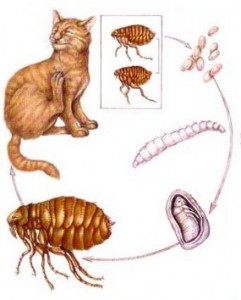 In the fight against fleas, treating your pet’s environment is as important as treating your pet. The flea goes through a lifecycle of egg → larva → pupa → flea. When the adult flea lays eggs on its host, those eggs fall off into bedding, carpet, floor crevices, et cetera. So if your pet is infested with fleas, so is your home. Thorough vacuuming and cleaning is the best way to attack this problem.
In the fight against fleas, treating your pet’s environment is as important as treating your pet. The flea goes through a lifecycle of egg → larva → pupa → flea. When the adult flea lays eggs on its host, those eggs fall off into bedding, carpet, floor crevices, et cetera. So if your pet is infested with fleas, so is your home. Thorough vacuuming and cleaning is the best way to attack this problem.
When it comes to purchased flea treatments, be very careful about ingredients. Pyrethrins are derived from chrysanthemums and are a good choice because they’re less toxic than other insecticides.They do, however, still affect the nervous system, which is the main problem of stronger insecticides.  The effect of pyrethrins is shorter lived, but they still get the job done. Synthetic pyrethrins are called pyrethroids, and are more potent than their natural counterparts. Examples of Pyrethroids include allethrin and permethrin. Permethrin is not as well tolerated by cats and toxicity is all too common. Still, among commonly used flea treatments, pyrethrins and pyrethroids are a better choice than most. Never use in dosages higher or more frequent than the label directs.
The effect of pyrethrins is shorter lived, but they still get the job done. Synthetic pyrethrins are called pyrethroids, and are more potent than their natural counterparts. Examples of Pyrethroids include allethrin and permethrin. Permethrin is not as well tolerated by cats and toxicity is all too common. Still, among commonly used flea treatments, pyrethrins and pyrethroids are a better choice than most. Never use in dosages higher or more frequent than the label directs.
D-limonene is another naturally derived insecticide that works well on dogs but is toxic to cats. And definitely avoid diazinon and malathion, two products used a great deal in the past. These can be extremely toxic to your pet. It should go without saying that you ought to never use products labeled “Avoid contact with skin.” Obviously if humans aren’t supposed to have the product even touch their own skin, it can’t be good for your pet.
even touch their own skin, it can’t be good for your pet.
As mentioned above, the best way to prevent a flea problem is to keep your pet healthy and to keep their environment clean. But odds are good that if you’re reading this right now, that advice is twenty-twenty hindsight. So, assuming you already have a flea problem, here are some steps you can take to both prevent and treat flea infestations. The following is from Dr. Pitcairn’s Complete Guide to Natural Health for Dogs and Cats.
- Have your carpets steam cleaned just before flea season, or whenever you start your battle against the varmints. Steam cleaning isn’t cheap, but it effectively kills flea eggs, and it’s better than hiring an exterminator or bombing your home with poisons.
- Thoroughly vacuum and clean carpets and furniture and mop floors, paying particular attention to the areas where your pet sleeps.
 The goal is to suck up eggs, larvae, and pupae. Destroy the vacuum bag afterward by burning it or dispose of it in a place where escaping fleas can’t re-infest your pet. You may also want to throw a piece of flea collar into the bag to kill fleas while you’re vacuuming. You’ll want to do this at least once a week, perhaps more during the height of flea season as the flea’s life cycle speeds up.
The goal is to suck up eggs, larvae, and pupae. Destroy the vacuum bag afterward by burning it or dispose of it in a place where escaping fleas can’t re-infest your pet. You may also want to throw a piece of flea collar into the bag to kill fleas while you’re vacuuming. You’ll want to do this at least once a week, perhaps more during the height of flea season as the flea’s life cycle speeds up.
- Using the same frequency, you’ll want to wash your pet’s bedding with very hot water and soap. There’s no sense going to all the trouble of the other steps if your pet is just going to be re-infested at every nap. If you have a pet bed that isn’t washable, you ought to throw it out. If fleas are a problem, washable bedding is a must. Even blankets or towels are better than a flea infested un-washable bed. Dry the bedding on maximum heat. Heat kills all stages of flea development. Be careful when you are transporting the bedding to the washing machine or washing area because eggs, larvae, pupae, and fleas will fall off.
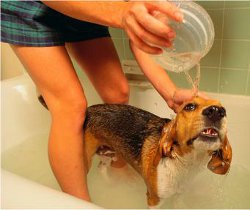 Bathe your dog or cat as described above. You don’t need a flea shampoo because any soap left to sit on your pet’s fur for fifteen minutes will kill the fleas. These natural methods take patience, but in return for your time you get rid of fleas without damaging your pet’s health. We think that’s a desirable exchange. At the beginning of the bath, make a ring of soap around your pet’s neck to stop fleas from fleeing to higher ground and escaping into ear canals. After the bath, rinse your pet with cooled rosemary tea.
Bathe your dog or cat as described above. You don’t need a flea shampoo because any soap left to sit on your pet’s fur for fifteen minutes will kill the fleas. These natural methods take patience, but in return for your time you get rid of fleas without damaging your pet’s health. We think that’s a desirable exchange. At the beginning of the bath, make a ring of soap around your pet’s neck to stop fleas from fleeing to higher ground and escaping into ear canals. After the bath, rinse your pet with cooled rosemary tea.
- Use a flea comb to remove and kill fleas on your dog or cat. Some combs are equipped to trap the little buggers in an attached containment area. If fleas are a current problem, you ought to be combing your pet every day,
 perhaps while you watch television. If you use a regular flea comb, have a container of hot, soapy water next to you to dunk the fleas into after removal. Use a towel on your lap, wash the towel after the combing, and flush the soapy flea water down the toilet.
perhaps while you watch television. If you use a regular flea comb, have a container of hot, soapy water next to you to dunk the fleas into after removal. Use a towel on your lap, wash the towel after the combing, and flush the soapy flea water down the toilet.
- Use an herbal flea powder. You can buy one or make one by mixing dried eucalyptus, rosemary, fennel, yellow dock, wormwood, and rue.
 Apply to your pet by brushing or rubbing your pet’s fur backward and sprinkling the powder into the base of the hairs. Do this outside because the fleas will jump off your pet.
Apply to your pet by brushing or rubbing your pet’s fur backward and sprinkling the powder into the base of the hairs. Do this outside because the fleas will jump off your pet.
- There are also herbal flea collars, but Dr. Michael Lemmon, in Keep Your Dog Healthy the Natural Way, is quoted as saying “some pets have problems with them.”
 Make a natural skin tonic by steeping a cut up lemon in boiling water and then letting it cool. The solution should steep for at least a few hours, better yet, overnight. Use this tonic sparingly on cats as the d-limonene from the lemon can be toxic in high doses.
Make a natural skin tonic by steeping a cut up lemon in boiling water and then letting it cool. The solution should steep for at least a few hours, better yet, overnight. Use this tonic sparingly on cats as the d-limonene from the lemon can be toxic in high doses.
- Have carpets treated with special anti-flea mineral salts. There are some newer products on the market that are safe.
For pets that go outdoors, here are a few more steps to take:
- Keep your lawn mowed and watered. Short grass allows sunlight to heat the ground and kill flea larvae. Watering drowns the developing fleas.
 Don’t kill ants. They eat flea eggs and larvae.
Don’t kill ants. They eat flea eggs and larvae.
- If it’s sunny out, cover bare areas with black plastic. This heats up the ground underneath, killing fleas and larvae.
- Apply agricultural lime on grassy or moist areas. This helps to dry out fleas.
Improve your pet’s diet as outlined in the diet section. As well, holistic veterinarians have stated that brewer’s yeast and garlic are good additives that may keep fleas away.  Brewer’s yeast is also a good source of B vitamins which may be the reason it helps, as B vitamins have been known to stimulate the body’s natural flea repellants. Some say garlic is bad for dogs, but veterinary naturopaths have been using it for decades to help with parasitic problems such as fleas and worms.
Brewer’s yeast is also a good source of B vitamins which may be the reason it helps, as B vitamins have been known to stimulate the body’s natural flea repellants. Some say garlic is bad for dogs, but veterinary naturopaths have been using it for decades to help with parasitic problems such as fleas and worms.
There is also a somewhat unconventional treatment called diatomaceous earth that may be worth looking into. Diatomaceous earth is a powder that has been used for a number of things including swimming pool filters. When it was being tested as an agricultural crop protectant, researchers did feeding tests on livestock to gauge how toxic or safe it was for affected farm animals. Surprisingly, the tests showed improved health in the animals fed the diatomaceous product.
The powder consists of diatoms, which are a microscopic hard-shelled algae. Apparently, diatoms remove worms and prevent infestation … and they prevent fleas. If you are considering using diatomaceous earth, be aware that the powder is not to be inhaled. Doing so can cause lung damage, so be very careful with the powder. For more information, here is link to a website on food grade diatomaceous earth. Also, if you do decide to try this treatment, make sure to buy a product that is specifically produced for pets. Don’t buy the kind that is sold for swimming pool filters. And don’t use for extended lengths of time.
Homeopathy
In addition to the steps for flea control listed above, give Sulphur 30c, two or three pellets, one time. A month later, if there is still a problem, give one treatment of two or three pellets of Calcarea carbonica 30c for cats and Silicea 30c for dogs.  These homeopathic treatments don’t kill fleas but they do improve your pet’s resistance to parasites.
These homeopathic treatments don’t kill fleas but they do improve your pet’s resistance to parasites.
If you follow the instructions above and still have persisting flea problems, have your holistic veterinarian check for worms. Poor health causes an animal to be susceptible to all sorts of problems, and creates a cascading effect of degeneration. Because worms sap your pet’s health and inhibit the body’s ability to absorb nutrients, they can be an underlying cause.
Again, it’s important that you treat fleas as soon as you spot one. The longer you let a flea problem fester, the harder it is to treat, and the more toxic the required treatment becomes. Fleas can carry disease and can cause complications such as anemia.
Lice
 Lice are a much less common problem for dogs and cats. They are somewhat lighter colored and smaller than fleas, and are therefore harder to see. Lice are species-specific so you can’t get your pets’ lice and they can’t get yours. The most noticeable sign of lice is scratching, but because this is such a common symptom of so many things, lice are noticed more by groomers than pet owners. Groomers use a high powered dryer to blow out your pet’s fur, and this exposes the skin where the lice attach themselves.
Lice are a much less common problem for dogs and cats. They are somewhat lighter colored and smaller than fleas, and are therefore harder to see. Lice are species-specific so you can’t get your pets’ lice and they can’t get yours. The most noticeable sign of lice is scratching, but because this is such a common symptom of so many things, lice are noticed more by groomers than pet owners. Groomers use a high powered dryer to blow out your pet’s fur, and this exposes the skin where the lice attach themselves. 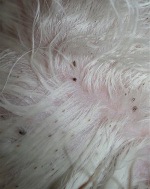
The treatments for lice are the same as those listed above for fleas. The hard part about lice eradication is that lice eggs are glued to hair strands. This is why the age-old mayonnaise method is often used. Mayonnaise doesn’t kill the lice or the eggs, but it detaches the eggs from the hair, enabling you to then wash and comb out the eggs. If you try the mayonnaise method, let it sit on your pet for at least forty-five minutes. Some people recommend following up the mayonnaise treatment with apple cider vinegar. Let that sit on your pet for an additional thirty minutes. Then shampoo and comb out your pet. The rosemary rinse described in the flea section, above, makes a good final treatment.
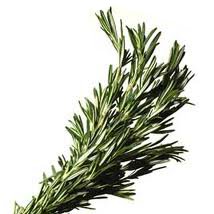 As with fleas, natural lice treatments require patience, but your time is worth it. Lice can carry disease and can cause complications such as anemia because they suck your pet’s blood. There are quicker fixes but they involve the use of insecticides that are harmful to your dog or cat. The last thing you want to do for a pet who is fighting parasites is to weaken them this way. Keeping their health up ought to be a top priority.
As with fleas, natural lice treatments require patience, but your time is worth it. Lice can carry disease and can cause complications such as anemia because they suck your pet’s blood. There are quicker fixes but they involve the use of insecticides that are harmful to your dog or cat. The last thing you want to do for a pet who is fighting parasites is to weaken them this way. Keeping their health up ought to be a top priority.
Mites
There are three types of mites that are commonly associated with pet problems – Demodex mites, scabies mites, and ear mites. Ear mites are discussed in the section on ear problems.
Demodex mites are microscopic and they live in hair follicles. Demodex mites often live undetected around the eyes and chins of pets, and they live around the eyebrows and nose of people. They are usually relatively harmless, and live on healthy animals as well as ill.
Sometimes puppies have a problem with these mites. The problem usually clears up naturally when the dog, if healthy, is about a year old. Sometimes, though, the mite infestation gets out of hand and causes hair loss, skin irritation, and pimples. This is what’s known as generalized demodectic mange. It can also spread to larger areas, and skin afflicted with mange is susceptible to staph infection.
Generalized demodectic mange is most common in dogs but is occasionally seen in cats. It is a very serious condition and must be treated by your holistic veterinarian.
Scabies mites cause sarcoptic mange, also referred to as simply scabies. Sarcoptic mange also must be treated by a holistic veterinarian as it can be difficult to treat and presents a serious health risk.
Make sure your pet does not get vaccinated while suffering from mange, as the body will not be able to handle the added stress to its health and immune system. The same goes for steroidal drugs. With mange, as with all parasitic  problems, the most important thing you can do for both prevention and treatment is to keep your pet’s health in top notch condition. Poor health and a weak immune system are what make the mange mites able to flourish on your pet. For tips on general dog and cat health, see the Overview, Holistic Veterinary Care, the immune system section of the Infections page, and various other pages in our Ailments A-Z section. A wholesome, natural diet is essential.
problems, the most important thing you can do for both prevention and treatment is to keep your pet’s health in top notch condition. Poor health and a weak immune system are what make the mange mites able to flourish on your pet. For tips on general dog and cat health, see the Overview, Holistic Veterinary Care, the immune system section of the Infections page, and various other pages in our Ailments A-Z section. A wholesome, natural diet is essential.
Unfortunately, most of the mainstream treatments for mites and mange involve heavily toxic substances. While these parasiticides do kill the mites, they also weaken the animal to a state that makes your pet susceptible to further infestations and to side effects and disease from the toxic preparations. 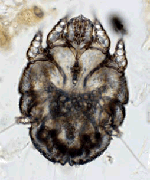
If the condition becomes out of hand, even a holistic veterinarian may have to resort to one of these toxic treatments, although he or she will probably opt for the least toxic of the options. The holistic veterinarian will also know what nutritional, herbal, and homeopathic steps need to be taken to detox the animal and reduce negative effects and secondary disease caused by treatment.
The veterinarian will probably want you to begin by fasting your pet. This is standard holistic treatment for this type of problem, and the fast may last up to a week. See Fasting in the First Aid section for more information.
Zinc, vitamin C, and vitamin E are important supplements for dogs and cats suffering from mange. Per ten pounds of body weight, give about 5 mg Zinc, 250 mg vitamin C, and 100 IU vitamin E. See Supplement Dosage Guidelines. Astragalus, Echinacea, and lecithin are also used for support.
A skin tonic made from steeping sliced lemons in boiling water overnight can be helpful. Rub this into the skin at least once a day, preferably more often, on dogs. Use sparingly on cats because the active ingredient, d-limonene, is toxic to them.
 Lavender oil, diluted tea tree oil, and a garlic and apple cider vinegar mixture are all solutions used topically on affected areas. Avoid the eyes and genitals.
Lavender oil, diluted tea tree oil, and a garlic and apple cider vinegar mixture are all solutions used topically on affected areas. Avoid the eyes and genitals.
Currently, there is debate on whether it is safe to use tea tree oil on pets. For years, tea tree oil (diluted) was often touted as a natural product to use for parasitic infections and infestations. However, many people advise not to use tea tree and other essential oils on pets, particularly on cats. They say that tea tree oil isn’t metabolized in cats the same way as it is in people, and it can build up internally and become toxic.
This can be true of many topical and oral medicines, though. The amount of the dose determines whether a treatment is helpful or harmful, and that applies to all sorts of products from prescription drugs to herbal remedies. In fact, the commonly used treatments that most vets prescribe for parasitic treatments are toxic to your pet. Any fat soluble product will build up in an animal’s system, and this includes humans. This is why you need to be careful with vitamins A, D, E and K.
One of the reasons essential oils such as tea tree can be dangerous to pets is that the animal will lick the treated area. If possible, apply a bandage after you apply any topical treatment to a localized area. Gauze pads, rolled gauze and paper tape are good tools for this task. For fleas, we don’t recommend tea tree oil because it’s too hard to stop your dog or cat from licking the affected area. Please consult with a holistic veterinarian if you are going to use an essential oil to treat your pet.
There are a number of homeopathic remedies, but you need to use them under the guidance of a veterinarian trained in homeopathy. The most general is Sulphur 30c, which is a good all-around remedy that makes your pet a less hospitable host.
 Ticks
Ticks
There are several kinds of ticks, some dangerous, some not so much. Paralysis ticks and ticks that carry Lyme disease are the ones you have to worry about.
As with the parasitic problems listed above, tick infestation can be prevented by good health, proper grooming, and routine home examinations. In addition, whenever your pet has been out in fields or forests, carefully check the fur for ticks using a fine toothed comb. Read the section on Lyme Disease for more information, and keep an eye out for signs of paralysis.
Tick Removal
The following information is from the Center for Disease Control’s website:
- Use fine-tipped tweezers to grasp the tick as close to the skin’s surface as possible.
- Pull upward with steady, even pressure. Don’t twist or jerk the tick; this can cause the mouth-parts to break off and remain in the skin. If this happens, remove the mouth-parts with tweezers. If you are unable to remove the mouth easily with clean tweezers, leave it alone and let the skin heal.
- After removing the tick, thoroughly clean the bite area and your hands with rubbing alcohol, an iodine scrub, or soap and water.

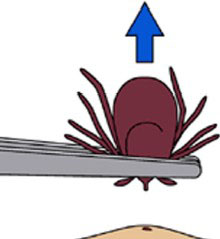
You may have heard of methods such as burning or painting the tick with an irritating substance, but don’t do this because the tick could regurgitate and cause a hypodermic effect in your pet.
If ticks get out of hand, you must see a holistic veterinarian. Ticks and fleas on your pet can fester to colonies of hundreds and even thousands, which will suck the life out of your pet if not treated.
Worms
Intestinal Worms –
Roundworms, Hookworms, Tapeworms, and WhipWorms
 Roundworms are commonly found in young animals and aren’t usually a serious problem. Most puppies and kittens get them from their mother, and pet owners don’t even know they’re there. If the worm infestation becomes heavy, you’ll see symptoms such as an extended belly, weight loss or inability to gain weight, and sometimes vomiting and diarrhea, in which you may see the spaghetti-like vermin.
Roundworms are commonly found in young animals and aren’t usually a serious problem. Most puppies and kittens get them from their mother, and pet owners don’t even know they’re there. If the worm infestation becomes heavy, you’ll see symptoms such as an extended belly, weight loss or inability to gain weight, and sometimes vomiting and diarrhea, in which you may see the spaghetti-like vermin.
 Roundworms will often lie dormant in adult pets but when passed on from a mother to a newborn, the worms sort of come to life. If the young animal is healthy and fed a well-balanced and natural diet, the worms will decrease in number and never pose a threat. All too often, as with vaccinations, worming treatments are administered when not necessary. This is why it’s important that you choose a veterinarian with a holistic mindset who has studied not just the regular vet school curriculum, but other areas, as well. This additional education equips your veterinarian with valuable knowledge and it also indicates that the person cares enough to learn more than just that which was required to get a job.
Roundworms will often lie dormant in adult pets but when passed on from a mother to a newborn, the worms sort of come to life. If the young animal is healthy and fed a well-balanced and natural diet, the worms will decrease in number and never pose a threat. All too often, as with vaccinations, worming treatments are administered when not necessary. This is why it’s important that you choose a veterinarian with a holistic mindset who has studied not just the regular vet school curriculum, but other areas, as well. This additional education equips your veterinarian with valuable knowledge and it also indicates that the person cares enough to learn more than just that which was required to get a job.
Adding raw, grated carrots, turnips, or beets to the diet helps, as does garlic. Some people use diatomaceous earth, as described in the section on fleas. And the homeopathic tablet Cina 3c given three times a day for a month has been known to support the body’s fight against these worms.
Hookworm infestations occur less frequently than other intestinal worm problems, and they’re more common in the south and in crowded and run-down neighborhoods. In cases of severe infestation, symptoms include pale gums from anemia, black and tar-like stools, weakness, and weight loss. Hookworm infestation can fester into a very serious condition as the worms suck the blood from their host. You must seek veterinary help if this happens, preferably from a holistic veterinarian.
they’re more common in the south and in crowded and run-down neighborhoods. In cases of severe infestation, symptoms include pale gums from anemia, black and tar-like stools, weakness, and weight loss. Hookworm infestation can fester into a very serious condition as the worms suck the blood from their host. You must seek veterinary help if this happens, preferably from a holistic veterinarian.
Tapeworms are a little different. Animals get tapeworms from eating other animals, particularly gophers and sometimes fleas. They grow in the small intestine and each worm has a head and a snake-like body made of distinct segments. The head attaches to the lining of the intestine, and each segment in the body is like an egg sac filled with new tapeworm eggs. Once the egg segment matures, it breaks off and is expelled in the animal’s stool.  The unattached segments look like maggots that move by transforming one of their ends into a point with which they move themselves along. If these segments dry out while hanging from the animal’s rear end, they look like pieces of rice.
The unattached segments look like maggots that move by transforming one of their ends into a point with which they move themselves along. If these segments dry out while hanging from the animal’s rear end, they look like pieces of rice.
The conventional treatment for tapeworms is a chemical product, but sometimes this vermicide just causes the breaking off of the segments, leaving the head still attached. When this happens, the head grows a new body. If you suspect your pet has tapeworms, see a holistic veterinarian. If your dog or cat is in good health, the tapeworms shouldn’t be an issue.  Healthy pets are able to deal with and expunge the vermin naturally. For tips on general dog and cat health, see the Overview, Holistic Veterinary Care, the immune system section of the Infections page, and various other pages in our Ailments A-Z section. And be sure to feed a natural, fresh-food diet.
Healthy pets are able to deal with and expunge the vermin naturally. For tips on general dog and cat health, see the Overview, Holistic Veterinary Care, the immune system section of the Infections page, and various other pages in our Ailments A-Z section. And be sure to feed a natural, fresh-food diet.
When trying to help your pet rid itself of parasitic tapeworms, you want to give them substances that annoy the worms over a long period of time until the worms eventually give up. Ground pumpkin seeds are a good way to do this. Keep the whole, raw seeds in a sealed container at room temperature. When it’s time to give them to your dog or cat, grind them in a seed grinder, coffee grinder, or food processor. Add about a teaspoon to each meal, a little more or a little less, depending on your pet’s weight. Pumpkin seeds are also a good source of zinc, which is in an immune system booster.
 Also add wheat germ oil and papaya enzymes to your pet’s meals. The wheat germ oil discourages tapeworms, and plant enzymes, particularly papaya, erode the outer layer of the worm’s coating. Homeopathic Felix mass 3c also helps. If Felix mass isn’t available, you can use Cina 3c.
Also add wheat germ oil and papaya enzymes to your pet’s meals. The wheat germ oil discourages tapeworms, and plant enzymes, particularly papaya, erode the outer layer of the worm’s coating. Homeopathic Felix mass 3c also helps. If Felix mass isn’t available, you can use Cina 3c.
Your holistic veterinarian will probably want you to begin by fasting your pet once a week. This is a standard holistic treatment for this type of problem because it deprives the worms of sufficient sustenance. See Fasting in the First Aid section for more information.
Sometimes castor oil is given after a fast. The fast weakens the worms, and the castor oil flushes them out. For young cats and puppies under three months, give ½ teaspoon. For adult cats and puppies three to six months, give 1 teaspoon. Depending on their size, give 1 ½ to 2 teaspoons for adult dogs.
Whipworms are different all together. Usually they are not detected because they lie dormant and don’t cause any alarming symptoms. If they get out of hand, however, the dog or cat will have persistent watery diarrhea. You will need the help of your holistic veterinarian to diagnose these types of worms, and he or she will assist you with treatment.
Heartworm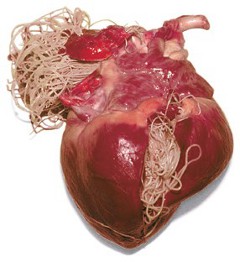
Heartworms are long, thin worms that live in the heart of a dog and, very occasionally, a cat. We’re going to focus on dogs in this section, because it is very rare that cats are infested.
An animal that has heartworms also has baby heartworms, called microfilaria, in its bloodstream. The only way a dog can be afflicted is by being bitten by a mosquito that is carrying microfilaria that it picked up when it sucked the blood of an infested dog.
One of the issues holistic veterinarians have with the ongoing preventative medications given to dogs nowadays is that science has shown that this huge boom in heartworm preventatives has not changed the rate of infestation. In Dr. Pitcairn’s Complete Guide to Natural Health for Dogs and Cats, Richard Pitcairn explains that the “incidence of heartworm infestation in dogs in any particular geographic area is the same now as it was in 1982, even after all these years of preventative treatment.”
 He and other veterinarians who have studied the subject argue that dogs in the wild are continuously subjected to heartworms. When bitten by a carrier mosquito, the dog develops a mild worm infestation, and then becomes immune. It’s estimated that up to fifty percent of dogs who live in heartworm ridden areas are the same way. They’ve already been exposed to heartworms, and their bodies have naturally dealt with it.
He and other veterinarians who have studied the subject argue that dogs in the wild are continuously subjected to heartworms. When bitten by a carrier mosquito, the dog develops a mild worm infestation, and then becomes immune. It’s estimated that up to fifty percent of dogs who live in heartworm ridden areas are the same way. They’ve already been exposed to heartworms, and their bodies have naturally dealt with it.
And the treatment, the pill you are told to give your dog each month, isn’t really a preventative, it’s a cure. It’s a chemical that kills baby worms, just in case a mosquito carrying the baby worms happens to bite your dog.
 This cure/preventative for heartworm is a toxic insecticide capable of causing disease. The monthly dosage is much smaller than the actual treatment, but when it’s administered month after month, the toxic side effects become a serious health risk.
This cure/preventative for heartworm is a toxic insecticide capable of causing disease. The monthly dosage is much smaller than the actual treatment, but when it’s administered month after month, the toxic side effects become a serious health risk.
Short term effects can include vomiting, diarrhea, convulsions, and weakness. But what’s more frightening is the effect they have on your pet’s immune system, long term, which recognizes the chemicals as poison. A great deal of stress is put on filtering organs such as the liver and kidneys. With the immune system and general health lowered, the dog becomes vulnerable to bacteria and viruses that are a normal fact of life, and it develops serious diseases more easily. Experts believe that the long-term use of heartworm prevention drugs has contributed to the increase in arthritis, skin conditions, allergies, autoimmune problems, liver disease, kidney disease, and more.
 In addition, Dr. Pitcairn tells us that the American Veterinary Medical Association’s records show that of all the adverse drug reactions reported, sixty-five percent were from heartworm preventatives, as well as forty-eight percent of all deaths caused by drug reactions.
In addition, Dr. Pitcairn tells us that the American Veterinary Medical Association’s records show that of all the adverse drug reactions reported, sixty-five percent were from heartworm preventatives, as well as forty-eight percent of all deaths caused by drug reactions.
This presents a difficult situation for holistic veterinarians. They can’t tell you to stop giving heartworm preventative medications because it’s possible that your dog will develop a life-threatening heartworm infestation. But holistic veterinarians know that in many cases this preventative treatment is not necessary and could actually be harming your pet.
An animal with a healthy immune system will be less likely to become infected with internal parasites, including heartworm. Mosquitoes are less likely to bite healthy animals. In addition, the healthy animal’s own defense system is able to kill off the larvae of any heartworm that may enter the bloodstream, thus preventing them from reaching maturity and causing harm. Factors that will weaken your pet’s 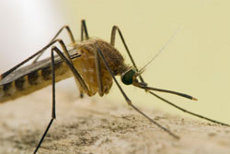 immune system include frequent vaccinations, commercial pet foods, incorrect diet, corticosteroids, stress, and conventional heartworm and some other synthetic medications.
immune system include frequent vaccinations, commercial pet foods, incorrect diet, corticosteroids, stress, and conventional heartworm and some other synthetic medications.
If a dog does become injected with microfilaria from a mosquito, and if the heartworms mature and reach the heart, and if they then fester and multiply out of control, then your dog has a serious problem. Heavy infestations of rampant heartworm make it difficult for the heart to perform normal functions. Shortness of breath, persistent coughing, lethargy, and weakness can ensue to the point of collapse and even death.
The best advice? Find a holistic veterinarian who you trust. This may take some research. I went to a veterinarian who I thought was holistic-minded because the clinic offered acupuncture,  but that doctor insisted I give heartworm medication to my uninfested dogs even through the thick of winter here in Colorado when there are no mosquitos around. So be choosy. It’s your right and your dog’s life. Sometimes it’s hard to find the right veterinarian because the sad fact is that it’s difficult for them to stay in business because they are not pushing the cash cows of vaccinations, steroids, antibiotics, and heartworm pills. Business is business. In addition, veterinarians who promote a natural diet often don’t see their clients again because the animals are so darn healthy. Veterinarians trained in naturopathy, homeopathy, and holistic medicine often find it hard to stay in business because they care too much to push those unhealthy cash cows on their clients.
but that doctor insisted I give heartworm medication to my uninfested dogs even through the thick of winter here in Colorado when there are no mosquitos around. So be choosy. It’s your right and your dog’s life. Sometimes it’s hard to find the right veterinarian because the sad fact is that it’s difficult for them to stay in business because they are not pushing the cash cows of vaccinations, steroids, antibiotics, and heartworm pills. Business is business. In addition, veterinarians who promote a natural diet often don’t see their clients again because the animals are so darn healthy. Veterinarians trained in naturopathy, homeopathy, and holistic medicine often find it hard to stay in business because they care too much to push those unhealthy cash cows on their clients.
 If your dog develops a bad heartworm problem, there really isn’t a good solution. You will probably have to use a hefty dose of the toxic drugs mentioned above, drugs containing an arsenic compound. These can cause serious secondary complications. Sometimes, in cases of minor infestations, this treatment has been worse for the animal than the worms. But other times it’s a matter of life or death and the lesser of two evils.
If your dog develops a bad heartworm problem, there really isn’t a good solution. You will probably have to use a hefty dose of the toxic drugs mentioned above, drugs containing an arsenic compound. These can cause serious secondary complications. Sometimes, in cases of minor infestations, this treatment has been worse for the animal than the worms. But other times it’s a matter of life or death and the lesser of two evils.
There are, however, natural methods for preventing heartworm, the crux of these methods centers on keeping your dog as healthy as possible. For tips on general dog and cat health, see Overview, Holistic Veterinary Care, the immune system section of the Infections page, and various other pages in our Ailments A-Z section. Feed a natural diet made from raw meat and other quality ingredients. Adding raw garlic and brewer’s yeast may help repel mosquitos. Some dogs are allergic to brewer’s  yeast, though, so watch for signs of new and intense scratching. Make sure that your pet’s diet contains ample amounts of antioxidants such as vitamins A, C, and E and selenium. The B-complex vitamins also add support, and CoQ10 may be beneficial.
yeast, though, so watch for signs of new and intense scratching. Make sure that your pet’s diet contains ample amounts of antioxidants such as vitamins A, C, and E and selenium. The B-complex vitamins also add support, and CoQ10 may be beneficial.
To further minimize the likelihood of being bitten by a carrier mosquito, keep your dog inside in the evenings. Make sure you don’t have water pooling around your yard, if possible.  Don’t discourage bats; they eat mosquitos. Use natural insect repellents on your dog. Diluted eucalyptus can be applied directly to your pet’s fur. Make sure to get some on the muzzle and the area between the anus and the genitals because these are favorite zones for mosquitos.
Don’t discourage bats; they eat mosquitos. Use natural insect repellents on your dog. Diluted eucalyptus can be applied directly to your pet’s fur. Make sure to get some on the muzzle and the area between the anus and the genitals because these are favorite zones for mosquitos.
Citronella, lemon thyme, and catnip have also been known to repel mosquitos. Citronella is popular on patios as a mosquito repellent, but if you choose to use it on your pet, you’ll have to repeat applications frequently as the effectiveness wears off fast.
Ringworm
Ringworm is actually a fungal infection, not a worm. See Ringworm.